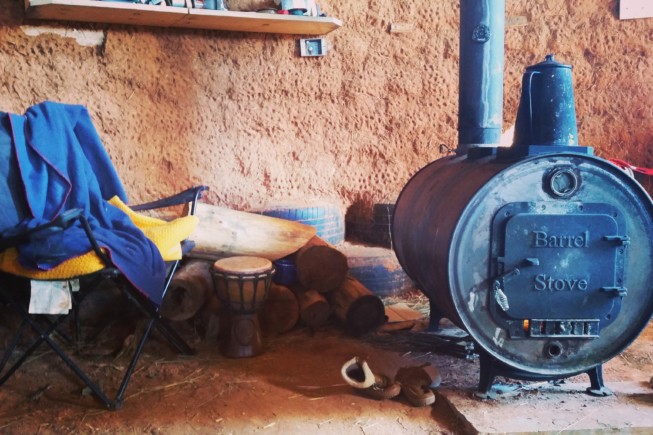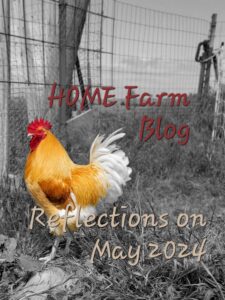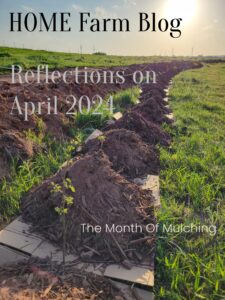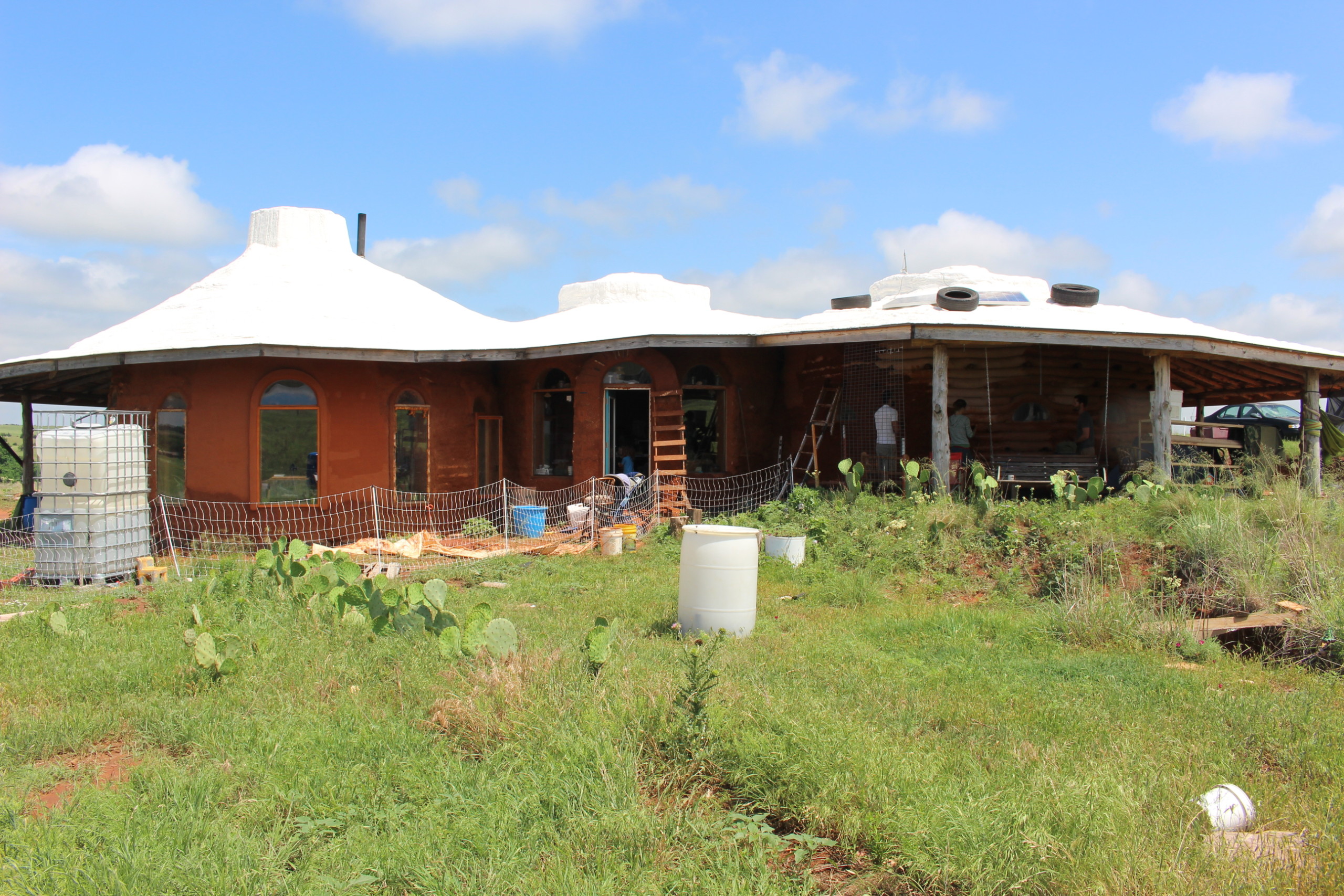Welcome to the new year, everyone who keeps up with H.O.M.E Farm shenanigans! Lots of new stuff is taking place so far at the homestead. I feel like I usually start off the monthly blog with some nice words about the weather. Well, it’s January. If you have ever lived in the upper 40 or so states of the continental US in January, you know that the ugly landscape, devoid of visible life, deserves no nice words. So instead, I’ll just jump right into the meat of the month.
One thing I want to tell you right off the bat is that we frequently post pictures on Instagram, so you can follow us on there if you search for #home-farm. That’s “hashtag home-farm” if you’re new to Instagram.
Our little one-room earthbag home on the prairie is fairing quite nicely this winter. We finished up with the Grace Ice and Water Sheild (elephant skin) over the east room. Yes!! That room is finally totally dry! Rain, ice, sleet, and heavy winds are no match for Grace’s underlayment.
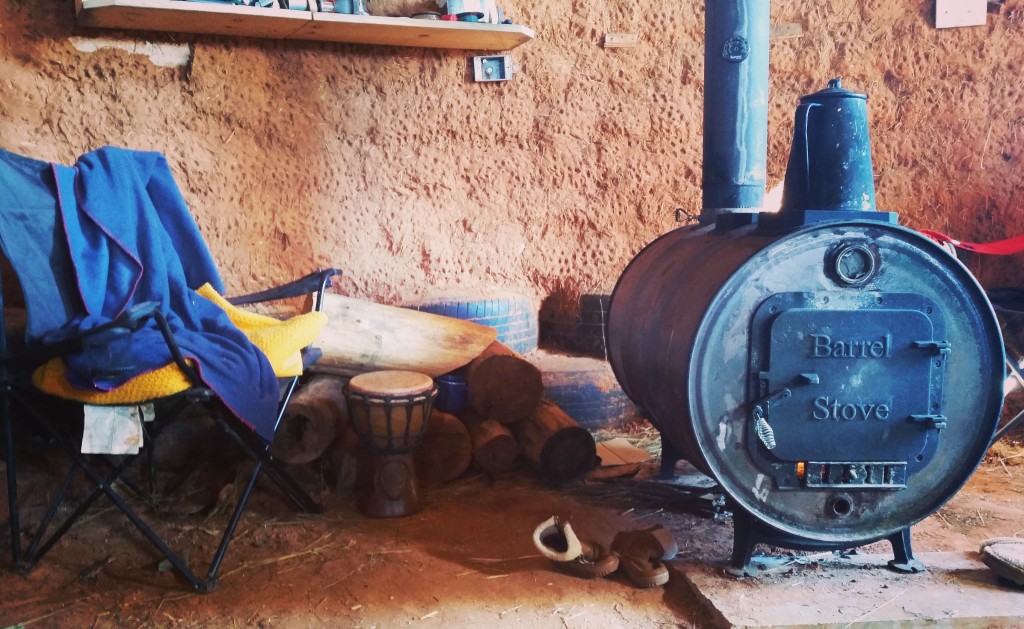
Our understanding of how the barrel stove works has improved with its use. At first, we were just throwing in lots of wood and burning it up real fast. As the fire sucks air from the room into the front of the barrel, it pulls the smoke and a lot of heat, up through the chimney. We discovered that having the fire as close to the front door as possible makes the heat travel farther before it escapes through the chimney. We also learned that closing the flue a bit keeps in more heat as well. During our 20 degree days, we were able to maintain about 65 inside. Of course, you can sit right by the fire and be warmer, which is my favorite thing about January. However, because we only have underlayment on the roof thus far, the heat slowly escapes overnight. On the coldest mornings though, after allowing the fire to die down through the night, we wake up to a nice 55 inside. Not bad! I believe the earthen walls are working as a battery, slowly releasing heat through the night, which is what they are supposed to do. Yay!
After hanging out in the room for a couple of days, we noticed it’s cave-like qualities. We had rigid foam insulation in three of the four small windows. Only one window had plexi-glass and let in some sun, if the sun was present, and even then, only between the hours of 4 and 6pm. So we quickly knocked the cob off from around the insulation, pushed it out and cobbed plexi-glass into those three windows and Bam! Lots more light.
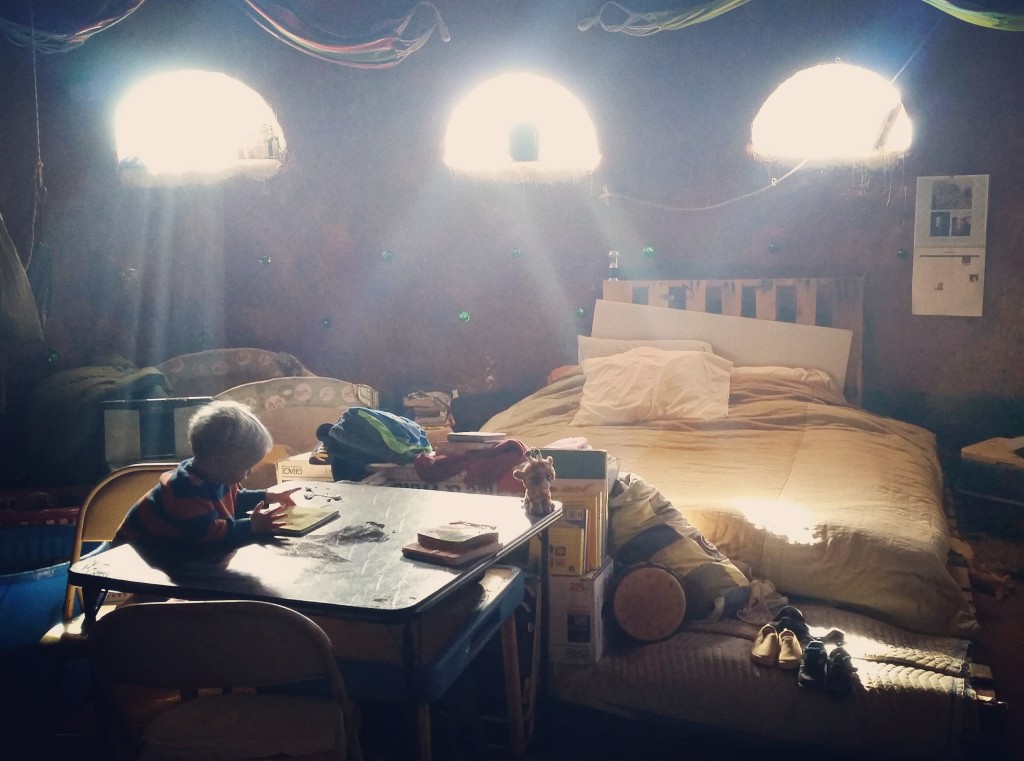
Like chickens determinedly pecking at a pile of seeds on the ground, we’re pecking away at the decking on our roof. Between availability of pallets, windy and icey days, and the infrequent occasions where we run out of decking screws, we’ve managed to nearly finish the west room’s decking. I am so thankful that Aaron is not afraid of heights because the west room’s roof pitch is about a 45 degree angle and I’ve been up there…once, to deliver him his drill. It is also the tallest roof and when it’s windy, it is really unnerving up there.
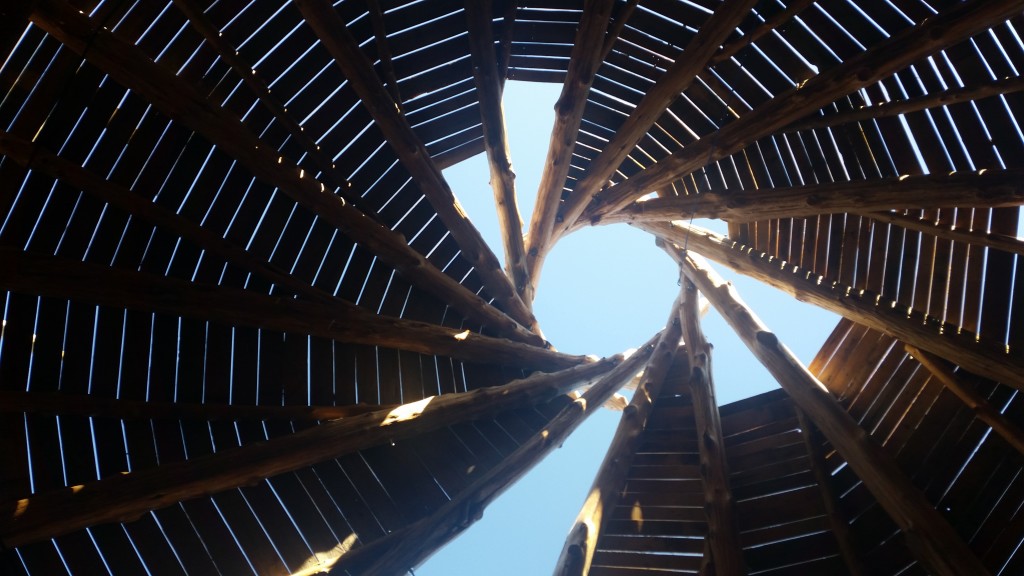
Like I said, we’ve been taking apart pallets, but that goes so slow, especially when the planks are brittle from the cold, and they break. So, the clubhouse, aka birthing stable, aka break room, must also be dismantled.
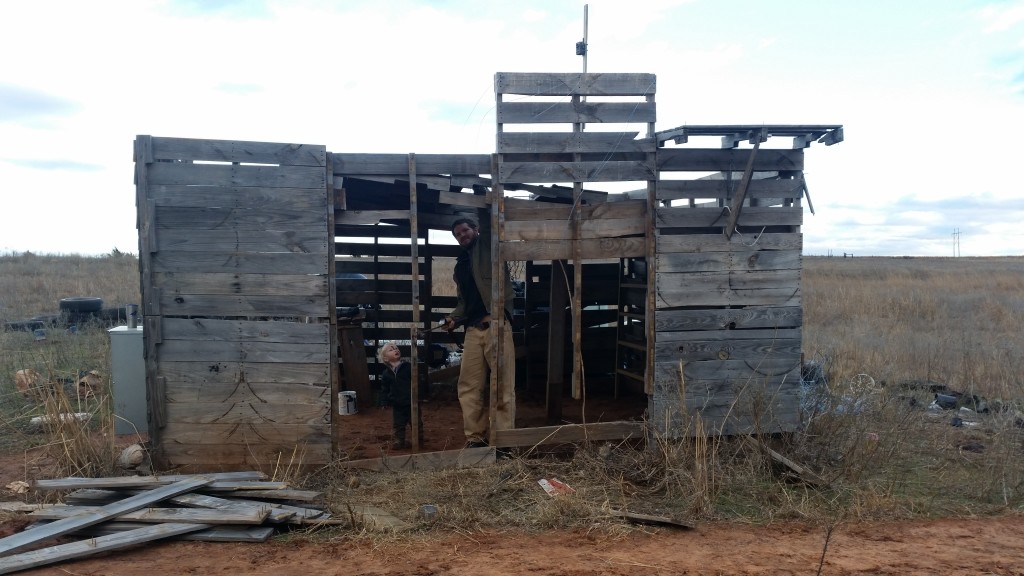
Let’s call it a transformation. A reincarnation of sorts. The boards which were harvested from a tree-farm, probably in Canada, were processed into boards that, when nailed, screwed, or stapled together, carried goods all across the United States. They were moved by forklift and by man onto and off of trucks, in store warehouses and maybe even into Wal-Marts or other stores. Then, they held boxes of food for Bountiful Baskets customers. After that, they came to our farm, were disassembled and repurposed into a clubhouse, which, imagining they have eyes, witnessed the family life at H.O.M.E. Farm, including the birth of a small human boy. They were disassembled yet again and attached to the roof of our house, where they can watch that very little boy grow up. That’s the anthropocentric story of the life of a pallet, you never knew you were missing.
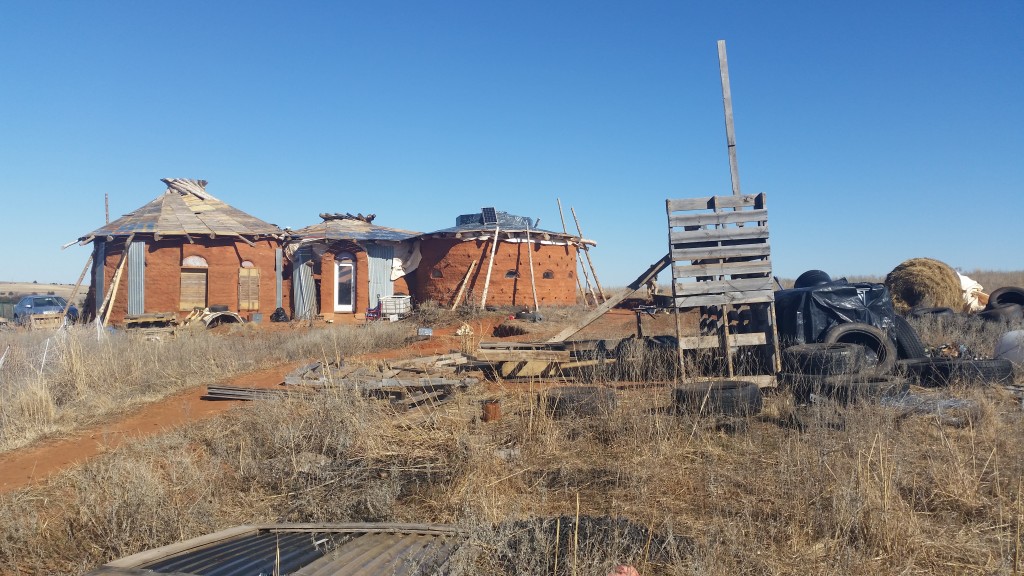
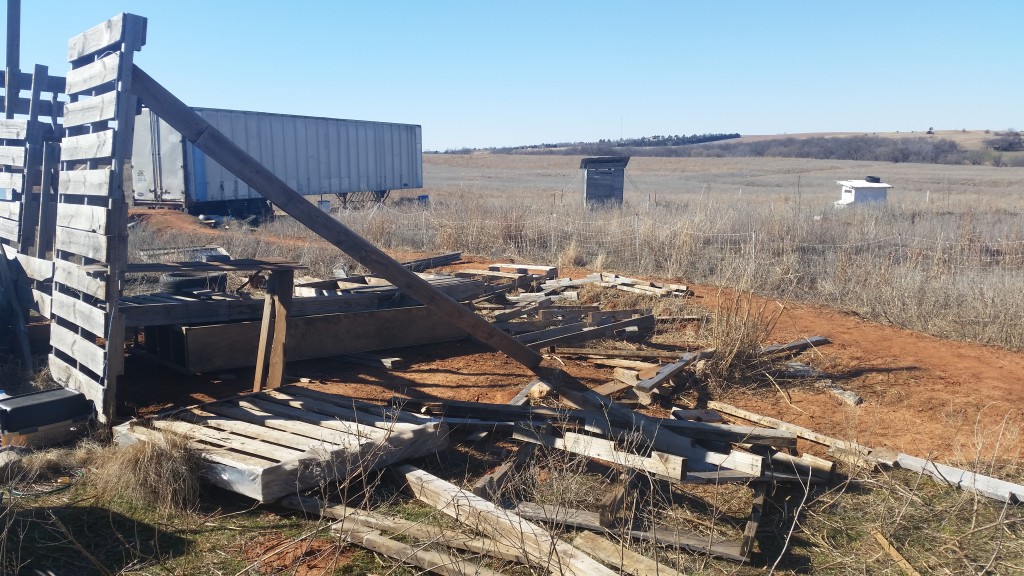
A bit of time in January was dedicated to making some updates to the website. You may notice, or maybe not, that the home page menu looks a bit nicer, some fonts have changed, and there are drop-down menus for the Earthbag Build section and the Homesteading Blog.
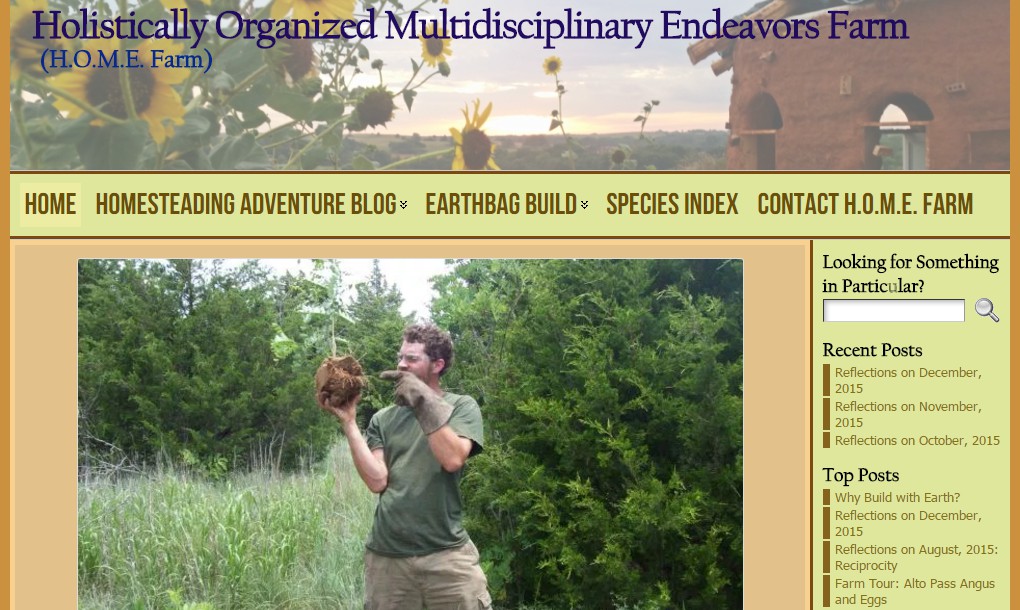
My brother recently asked me why I use WordPress and not Squarespace for our website and blog (maybe I complained on Facebook about web building being so time-consuming). I summed up my answer with this analogy: You can spend a bit more money and go to a name-brand store to buy shirts, neatly arranged by style, color, and what’s fashionable in a particular season. You won’t have to spend as much time, but you will spend more money. The other option is to go to a Goodwill or other thrift store and sort through a hodge podge of clothing and you’ll spend a bit more time, but less money, and you might find a really unique treasure that becomes your favorite shirt.
So is the equivalent of using an open-source site like WordPress. It takes a lot of time. Before I do something like add drop-down menus to my home-page, I have to find the right vocabulary for what that even is. Often, I start out with an idea that I see on someone else’s website and I think, “oh yeah, I want to have a word thingy where some words are bigger than others!” Well, if you Google that, you’re bound to find a kindergarten word-learning software, or some such thing, not a so-called “tag cloud,” which I have now added to the side bar. Then, I have to locate the widget or plug-in to implement that idea, and make subtle changes to it so that it meshes well with the overall feeling of the website (bright pink unicorn stickers in the background are not my style) and then see how it functions on the site and make sure the plug-ins don’t contradict one another. Jeremy Wong wrote a great article highlighting the differences between Squarespace and WordPress here, that goes into a bit more depth than I have. So, upgrades to the site take time. I enjoy being able to figure this stuff out on my own. And, just like our house, each little upgrade is an improvement from the last, and it always gets better!
Our health may be getting better as we eat more of Aaron’s mushrooms. So, one way to grow mushrooms is to start them on grain. We’ve been using wheat berries. By the way, anytime I say “we” and it involves the planning, researching, or growing of mushrooms, I mean Aaron. If I’m talking about cooking or eating them, then “we” includes both of us. That being said, “we” begin the growth on wheat berries. Specifically, we’ve recently used the Phoenix oyster mushroom, Pleurotus pulmanarius. After the mycelium takes hold, the little grains are covered in mycelium, and are then referred to as myceliated grains. Now after they have taken hold, they can be transferred to straw or some other medium and grown into actual mushrooms. However, they can also be consumed at the myceliated grain stage. I was really grossed out by this at first, but after frying the myceliated wheat berries in butter and adding them to scrambled eggs, I suddenly realized the potential for adding these little morsels of nutrition into many other dishes. We’ve added them to eggs, stir-fry, and even our breakfast waffles! You can barely taste them, yet they add a little crunchy texture to the waffles, which I really like! My favorite thing to add them to is meatloaf. Perhaps I’ll post a recipe one day.
Aaron has also, quite by accident, grown out some oyster mushrooms at H.O.M.E. farm and learned that mushrooms do in fact need some indirect light, even though they don’t photosynthesize like plants, and because they are 70% water, also benefit from some light misting. He was growing them in these containers, where, without adequate fresh air, they grow “pins” with large stems, but not the idyllic caps you see in this photo. Here, the mushroom pushed out the air hole and has been growing so fast with the aforementioned growth parameters.
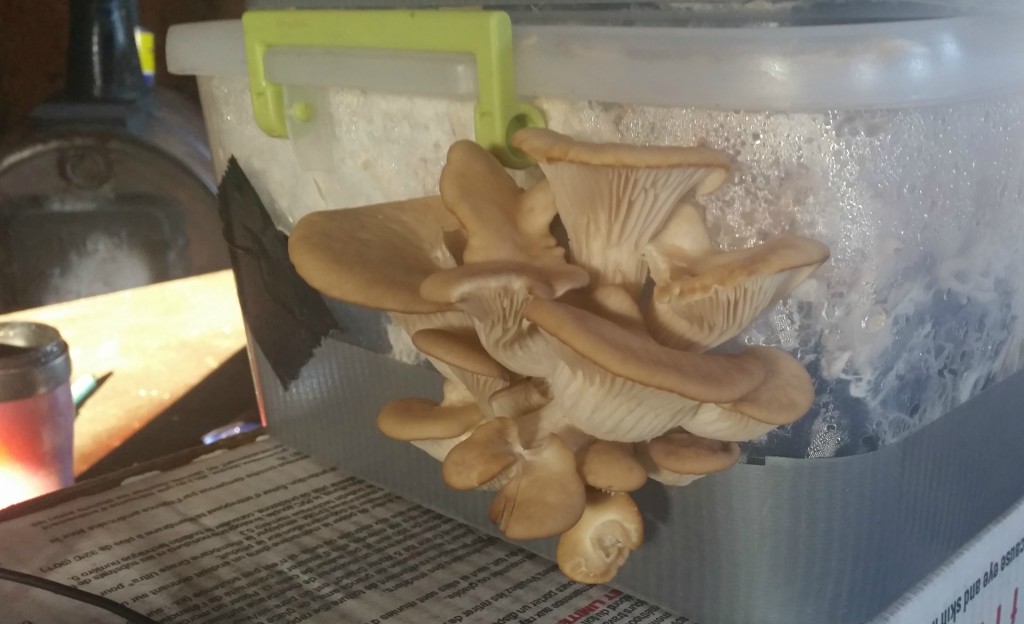
The other awesome improvement that came about this month is that we got some barrel stove-top burners for our heat source, giving it new purpose: cooking! We quickly put away the smelly gas camp-stove and now use the barrel stove exclusively for heating up coffee, cooking bacon and eggs, and dinners of all sorts, and pressure cooking Aaron’s mushroom jars! Can you imagine how wonderful it is to be cold (as I usually am) and get to stand next to such a solacing heat source and make delicious foods? Well it sure beats how we used to do it, huddled around a smoky firepit, next to the clubhouse in the wind.
That’s the thing about starting from zero; everything is an improvement, a step closer to the ultimate comfort. Of course, stepping outside of one’s comfort zone really opens up new ideas of what comfort really means to a person. But night now, it is really comfortable in our one-room home, especially at night, snuggled in bed reading books to the little one, hearing the crackle of the fire in the barrel, and the smell of clean, dry sheets. The wind howls outside, but behold! It can’t touch us inside these thick walls of earth.
